Time can wash away many things. But for Taiwan's coal miners, time has never taken away the memories of their now dismantled industry; their proud contribution to the nation's economy, the constant hazard of their profession and the black lung disease that is now killing many.
But time many soon wash away this, too.
Take a trip to Taipei's Pingshi village, where New Pingshi Coal Mining Corp (
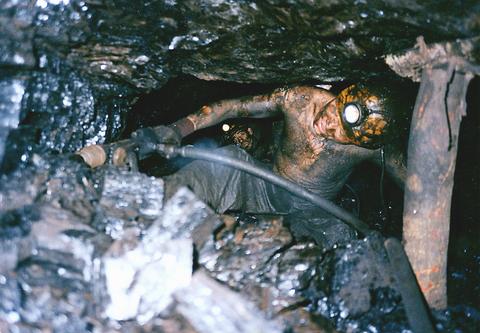
In fact, New Pingshi remains well-kept by comparison. In Ruifang (
Wang Kuo-wei (
In the 1960s and 1970s, Taiwan had more than 400 coal mines and more than 60,000 miners working in the pits every day producing some five million tonnes annually. Half the coal was used in power plants and the other half for export. "Our history can be traced back to 1875, when British ships came to Keelung port requesting coal for fuel," said Wang, citing a book called Keelung Coal History, published by the Keelung City Government.
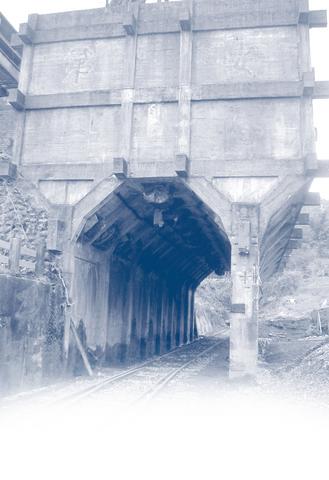
Taiwan's coal miners were especially hard workers. The mine veins run deep, around 400m underground. The narrow pits were dug between fragile sandstone. Miners worked lying down, constantly alert of collapse, or any spark that might trigger an explosion. "The temperature there is 40C and humidity is 90 percent; many of us worked naked," Wang said.
The thickness of Taiwan's mining seams is less than a meter on average, making it hard to use large machines to excavate the mines. It depended heavily on labor, which raised the cost. In 1984, there were three major explosions that killed a total of 180 miners. That, combined with the coal's high cost (around three times higher than imported coal), caused Taiwan's coal industry to wither in the late 1980s. In 2000, when Lifong Coal Mine Corp stopped production, the 100-year-old industry came to a close in Taiwan.
"We are now running against time," said Shueh Li-ni (
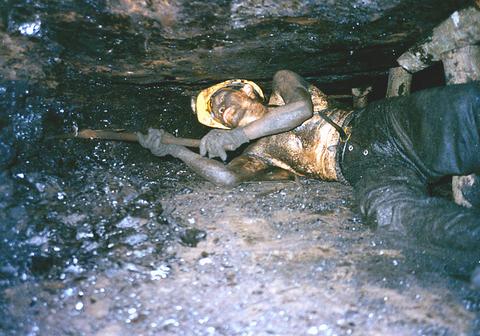
PHOTO COURTESY OF WANG KUO-WEI
"The old miners are gradually falling, and the history and culture might soon be forgotten. Thanks to Mr Lin, we now have a small place to display these historical pieces," Shueh said.
Lin Tsai-sheng (
"It's very humble, but we hope to make a start. We need more donations," Shueh said. The Keelung museum is one of the few attempts to preserve Taiwan's coal mining culture. In 1998, Taipei County Government announced plans to build a large coal mine museum and memorial in Houtong (侯桐), the old site of Ruisan Coal Mine Corp. But the project is still only on paper, according to the county government's construction bureau. The government also has a plan to set up a memorial park at another mine in Shihti. That project, also announced in 1998, remains on ice.

PHOTO: YU SEN-LUN, TAIPEI TIMES
"We set up this small museum in haste, but at least it's something to fulfill Lin's wish before it's too late.
"I want to see the history and knowledge of coal mines passing down to future generations. Besides, I can't bring these things to my grave," Lin told the Taipei Times by phone. Suffering from skin cancer, Lin said with a voice of gravel that he was unable to give a longer interview.
Another race against time is the black lung disease with which many coal miners struggle. Most miners worked in the mines more than 10 years, and none of them are immune to the incurable disease. Filmmaker Wu Nien-jen's (吳念真) Dohsan -- A Borrowed Life (多桑, 1994) vividly depicts his father's suffering from the disease, unbearable difficulty with breathing, constant coughing and other complications. The father eventually jumped off the hospital roof to end his pain.
"We feel very strongly about the film and don't really want to see it again," said Wang Kuo-wei who has been diagnosed with light symptoms of black lung disease. But Wang's co-worker, surnamed Chen, is a lot worse. He has now been diagnosed with severe symptoms of the disease, but when he was first diagnosed 15 years ago, he was already retired.
Before labor insurance regulations were amended in 1999 to accommodate those suffering from occupational diseases after having left employment, Chen had not received a penny for his sickness. In April of this year, the Council of Labor Affairs passed the Occupational Disease Protection Law, which gives a monthly allowance of NT$1,000 to NT$6,000 to those suffering from occupation-related diseases. But the law was not made retroactive and only those diagnosed with black lung diseases after April this year are eligible. "It's still too late for me," said Chen. Now working as a street cleaner to support himself, Chen has been quiet about his rights for many years.
In Dohsan, the father always looked stern and stubbornly never admitted to his pain. This same spirit is true of many old Taiwanese miners, according to Wang. "One reason you would take on such hazardous work is that you would rather grit your teeth and take the risk than ask for money from people," Wang said. This is the reason miners have remained quiet in the labor movement. Retired miners only staged a few protests demanding greater labor payments in the past five years. "They don't like to ask people to give them money," Wang said. "But they might well be the most disadvantaged."

The Taipei Times last week reported that the rising share of seniors in the population is reshaping the nation’s housing markets. According to data from the Ministry of the Interior, about 850,000 residences were occupied by elderly people in the first quarter, including 655,000 that housed only one resident. H&B Realty chief researcher Jessica Hsu (徐佳馨), quoted in the article, said that there is rising demand for elderly-friendly housing, including units with elevators, barrier-free layouts and proximity to healthcare services. Hsu and others cited in the article highlighted the changing family residential dynamics, as children no longer live with parents,
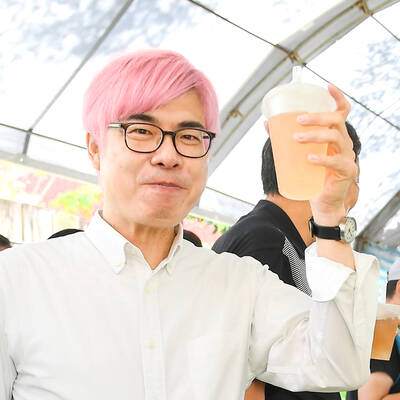
It is jarring how differently Taiwan’s politics is portrayed in the international press compared to the local Chinese-language press. Viewed from abroad, Taiwan is seen as a geopolitical hotspot, or “The Most Dangerous Place on Earth,” as the Economist once blazoned across their cover. Meanwhile, tasked with facing down those existential threats, Taiwan’s leaders are dying their hair pink. These include former president Tsai Ing-wen (蔡英文), Vice President Hsiao Bi-khim (蕭美琴) and Kaohsiung Mayor Chen Chi-mai (陳其邁), among others. They are demonstrating what big fans they are of South Korean K-pop sensations Blackpink ahead of their concerts this weekend in Kaohsiung.

Taiwan is one of the world’s greatest per-capita consumers of seafood. Whereas the average human is thought to eat around 20kg of seafood per year, each Taiwanese gets through 27kg to 35kg of ocean delicacies annually, depending on which source you find most credible. Given the ubiquity of dishes like oyster omelet (蚵仔煎) and milkfish soup (虱目魚湯), the higher estimate may well be correct. By global standards, let alone local consumption patterns, I’m not much of a seafood fan. It’s not just a matter of taste, although that’s part of it. What I’ve read about the environmental impact of the
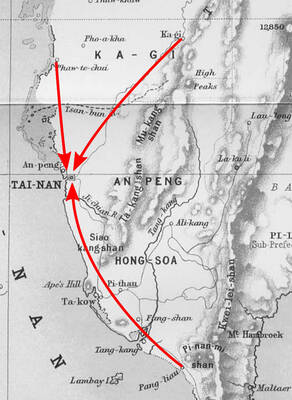
Oct 20 to Oct 26 After a day of fighting, the Japanese Army’s Second Division was resting when a curious delegation of two Scotsmen and 19 Taiwanese approached their camp. It was Oct. 20, 1895, and the troops had reached Taiye Village (太爺庄) in today’s Hunei District (湖內), Kaohsiung, just 10km away from their final target of Tainan. Led by Presbyterian missionaries Thomas Barclay and Duncan Ferguson, the group informed the Japanese that resistance leader Liu Yung-fu (劉永福) had fled to China the previous night, leaving his Black Flag Army fighters behind and the city in chaos. On behalf of the